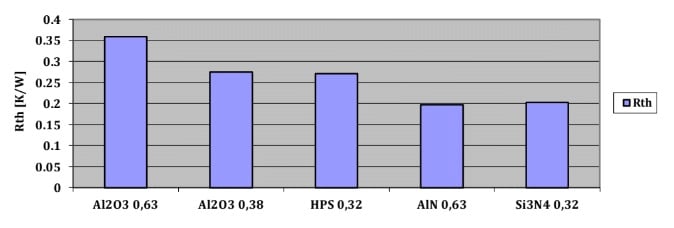Silicon Nitride Substrates for Improved Performance in Power Electronics
This article discusses the comparison between silicon nitride substrates and other materials and offers insights of Silicon Nitride Substrates.
Today’s power module designs are primarily based on aluminum oxide (Al2O3) or AlN ceramic, but increasing performance demands are causing designers to consider advanced substrate alternatives. One example is seen in xEV applications where an increase in the chip temperature from 150°C to 200°C reduces switching losses by 10%. Additionally, new packaging technologies like solder and wire-bond-free modules are making the current substrates the weak link.
Another significant driver of special importance is the need for an increased lifetime under harsh conditions such as with wind turbines. Wind turbines have an expected lifetime of 15 years without failure under all environmental conditions, causing designers of this application to look for improved substrate technologies as well.
A third driver for improved substrate options is the emerging use of SiC components. The first modules using SiC and optimized packaging showed a loss reduction of between 40 to 70 % compared to traditional modules but also presented the need for new packaging methods, including Si3N4 substrates. All these trends will limit the future role of traditional Al2O3 and AlN substrates, while substrates based on Si3N4 will be the designer’s choice for high-performance power modules in the future.
The excellent bending strength, high fracture toughness, and good thermal conductivity make silicon nitride (Si3Ni4) well suited for power electronic substrates. The characteristics of the ceramic and a detailed comparison of key values like partial discharge or crack growth show a significant influence on the final substrate behavior like heat conductivity and thermal cycling behavior.
Comparison of Si3N4 and Other Ceramics
The main properties for selection of insulating materials for power modules are thermal conductivity, bending strength, and fracture toughness. High thermal conductivity is critical for rapid heat dissipation in a power module. The bending strength is important for handling and usability of the ceramic substrate in the packaging process, while the fracture toughness is key in predicting reliability.
|
Thermal Conductivity |
Al2O3 96% | AIN | ZTA (9%) | Si3N4 |
|
Thermal conductivity [W/mK] |
24 |
180 |
28 |
90 |
|
Bending strength [MPa] |
450 |
450 |
700 |
650 |
|
Fracture toughness [MPa /√m] |
3,8-4,2 |
3-3,4 |
4,5-5 |
6,5-7 |
Table 1
As seen in Table 1, Al2O3 (96%) shows low thermal conductivity and low mechanical values. However, the thermal conductivity of 24 W/mK is sufficient for many of today’s standard industrial applications. The big advantage of AlN is the very high thermal conductivity of 180 W/mK, despite having only moderate reliability. This is a result of the low fracture toughness and similar bending strength to Al2O3.
The increasing demands for higher reliability spurred the development of ZTA (zirconia toughened alumina) ceramics recently. These ceramics show significantly higher bending strength and fracture toughness. Unfortunately, the thermal conductivity of ZTA ceramics is in the same range as standard Al2O3 and therefore is of limited use in high power applications with the highest power densities.
A comparison shows that Si3N4 combines high thermal conductivity with high mechanical performance. The thermal conductivity can be specified at 90 W/mK, and it has the highest fracture toughness of the compared ceramics (6,5 – 7 [MPa / ]). These properties lead to the expectation that Si3N4 will show the highest reliability as a metalized substrate.
Reliability of Metalized Substrates
Several different metalized substrates were tested for reliability with a passive thermal cycling method. All substrate combinations are shown in Table 2. For each combination, the same layout was used, including the same copper thickness d(Cu) = 0.3 mm. There were no additional design features like dimples or step etching to increase reliability. The test conditions were defined as follows:
- 2 chamber test systems
- dT = 205 K (-55°C to +150°C)
- exposure time 15 min
- ramp up time < 10 s
The different specimens were checked by an ultrasonic microscope to detect delamination and conchoidal fracture:
- after every 5 cycles for Al2O3, HPS9% (ZTA) and AlN DBC
- after every 50 cycles for Si3N4 AMB (active metal brazing)
| Combination | Copper Layoutside (mm) | Ceramic (mm) | Copper Backside (mm) | Thermal Cycles (1) |
| Al2O3 DBC | 0.3 | 0.38 | 0.3 | 55 |
| HPS 9% (ZTA) DBC | 0.3 | 0.32 | 0.3 | 110 |
| AlN DBC | 0.3 | 0.63 | 0.3 | 35 |
| Si3N4 AMB | 0.3 | 0.32 | 0.3 | 5000 |
Table 2
Conchoidal fracture is the typical failure mode in temperature cycling and was detected on Al2O3, HPS9%, and AlN -DBC substrates. In general, this breakdown appears due to the different thermal expansion values of copper and ceramic during temperature changes.
The lowest reliability in thermal cycling was observed for AlN DBC substrates with 35 cycles. This result can be explained by the lowest measured fracture toughness (K1C = 3 - 3,4 [MPa / ]) of the ceramic. Very close to this result is Al2O3 DBC with 55 cycles. The best performance for the traditional materials was demonstrated by the HPS9% DBC, with two times higher reliability (110 cycles) than standard Al2O3.
No failures of the Si3N4 AMB samples have been detected at 5000 cycles. The reliability could be increased by a factor of 45x compared to HPS9% DBC. The outstanding result of 5000 thermal cycles was achieved due to the high fracture toughness of Si3N4 (K1C = 6,5 - 7 [MPa / ]) even though the bending strength is slightly lower than HPS9% (650 MPa vs. 700 MPa).
These results highlight that the bending strength of ceramics used to build metalized substrates is not key to the lifetime of the substrate. The physical property of the ceramic that is most important to predict reliability appears to be fracture toughness.
Figure 1. The main difference in failure mechanism of HPS9% DBC substrates and Si3N4 AMB after several thermal cycles.
Figure 2. The Si3N4 ceramic material is still undamaged after more than 5000 cycles.
Picture 1 and 2 shows ultrasonic pictures of the main difference in failure mechanism of HPS9% DBC substrates and Si3N4 AMB after several thermal cycles. While we can detect a conchoidal fracture inside the brittle HPS9% ceramic material, the Si3N4 ceramic material is still undamaged after more than 5000 cycles.
Thermal Performance of Substrates
Five different groups of metalized substrate samples were measured for thermal resistivity (Rth).
Diagram 1 shows the results of our thermal resistivity testing. All specimens used for this Rth analyses were metalized with 0.3 mm copper layer on both sides. As expected, the substrate using 0.63 mm Al2O3 showed the highest Rth. This is caused by the low thermal conductivity of Al2O3 (24W/mK).
Diagram 1: Results of our thermal resistivity testing.
The Rth of the 0.32 mm HPS 9% DBC and 0.32 mm Al2O3 DBC were in the same range.
The AlN DBC with the highest thermal conductivity of 180 W/mK had the lowest Rth despite using a 0.63 mm thick ceramic layer.
The thermal conductivity of Si3N4 (90W/mK) is half that of AlN and explains why the Si3N4 AMB shows a similar Rth to AlN DBC by using half of the ceramic thickness (0.32 mm for Si3N4 compared to 0.63 mm for AlN).
Longer Life Cycles of Power Modules
The increasing demand for longer life cycles and higher thermal performance in power modules can be realized with high strength Si3N4 insulating material.
The investigation showed that the reliability of Si3N4 was better by a factor of 50 using Si3N4 AMB (active metal brazing) technology compared to conventional HPS9% DBC ceramic materials. The higher mechanical properties of Si3N4 ceramic, especially its very high fracture toughness (K1C) contributes to its enhanced reliability. Furthermore, Si3N4 higher strength allows it to be used with a thinner cross-section giving it a comparable thermal performance to AlN.
About the Author
Manfred Goetz holds a Dipl. Ing in Electrical Engineering at East Bavarian Technical University Regensburg. He currently works at Rogers Germany as the Global Marketing Manager.
This article originally appeared in the Bodo’s Power Systems magazine.









